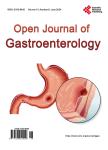Molecular Characterization of Gastrointestinal Stromal Tumors (Gist) and Contribution of Immunohistochemistry in Congolese from Kinshasa
Molecular Characterization of Gastrointestinal Stromal Tumors (Gist) and Contribution of Immunohistochemistry in Congolese from Kinshasa作者机构:Faculty of Medicine Bel Campus Technological University Kinshasa DR Congo Department of Anatomy and Pathological Cytology University Clinics of Kinshasa Kinshasa DR Congo Department of Gyneco-Obstetrics University Clinics of Kinshasa Kinshasa DR Congo Molecular Biology Department Faculty of Medicine University of Kinshasa Kinshasa DR Congo Institute of Medical Immunology Free University of Brussels Ixelles Belgium
出 版 物:《Open Journal of Gastroenterology》 (肠胃病学期刊(英文))
年 卷 期:2024年第14卷第4期
页 面:109-116页
学科分类:1002[医学-临床医学] 100214[医学-肿瘤学] 10[医学]
主 题:Digestive Tumors GIST Immunohistochemistry CD117 DOG-1
摘 要:Introduction: The differentiation of digestive tumors very often requires the use of techniques currently not widely in use in the Democratic Republic of Congo (DRC), such as immunohistochemistry. This is perfectly verified for GISTs whose precise, or at least highly certain, diagnosis can only be made using immunohistochemical markers. This underuse of these techniques due to lack of equipment and human skills explains the limited epidemiological data available to date, thus leading to untargeted and too often late treatment of patients. Research question: What contribution can immunohistochemical markers make to the diagnosis of digestive tract tumours? Objective: Discuss the contribution of immunohistochemical markers in the diagnosis of GIST and provide basic data on the epidemiology of these nosological entities in Kinshasa. Methodology: This was a retrospective study carried out at the LEBOMA private anatomy and pathological cytology centre. The main inclusion criterion was any digestive tract block or slide whose diagnosis of GIST had been requalified after review by at least 2 pathologists. An immuhistochemical study was performed using an automated technique (with a Ventana XT machine) using a panel of antibodies: CD-117 and DOG-1 which are listed in the literature as strongly correlated with the occurrence of GIST, all slides were made at Hj Hospital using an OLYMPUS BX41 co-observation microscope. Results: Of 601 cases of digestive tumors recorded during the concerned period, 32 (5.32%) concerned GIST. This prevalence was confirmed by our immunohistochemical results where the expression of CD117 and that of DOG-1 were positive in 90.6% and 100% of cases which prevalence is high compared with the worldwide prevalence according to the literature, respectively. The distribution of the patients concerned was made with a sex ratio of 1.6 women/men with a median age of 53 years. Most cases (81%) had a gastric location and were fusiform GISTs. Conclusion: Gastro



